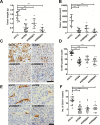Role of cystathionine beta synthase in lipid metabolism in ovarian cancer
- PMID: 26452259
- PMCID: PMC4741935
- DOI: 10.18632/oncotarget.5424
Role of cystathionine beta synthase in lipid metabolism in ovarian cancer
Abstract
Elevated lipid metabolism is implicated in poor survival in ovarian cancer (OC) and other cancers; however, current lipogenesis-targeting strategies lack cancer cell specificity. Here, we identify a novel role of cystathionine beta-synthase (CBS), a sulphur amino acid metabolizing enzyme highly expressed in several ovarian cancer cell lines, in driving deregulated lipid metabolism in OC. We examined the role of CBS in regulation of triglycerides, cholesterol and lipogenic enzymes via the lipogenic transcription factors SREBP1 and SREBP2. CBS silencing attenuated the expression of number of key enzymes involved in lipid synthesis (FASN and ACC1). Additionally CBS abrogates lipid uptake in OC cells. Gene silencing of CBS or SREBPs abrogated cellular migration and invasion in OC, while ectopic expression of SREBPs can rescue phenotypic effects of CBS silencing by restoring cell migration and invasion. Mechanistically, CBS represses SREBP1 and SREBP2 at the transcription levels by modulating the transcription factor Sp1. We further established the roles of both CBS and SREBPs in regulating ovarian tumor growth in vivo. In orthotopic tumor models, CBS or SREBP silencing resulted in reduced tumor cells proliferation, blood vessels formation and lipid content. Hence, cancer-selective disruption of the lipid metabolism pathway is possible by targeting CBS and, at least for OC, promises a profound benefit.
Keywords: CBS; SREBP; lipid metabolism; ovarian cancer.
Conflict of interest statement
No potential conflicts of interest.
Figures








Similar articles
-
Melittin suppresses ovarian cancer growth by regulating SREBP1-mediated lipid metabolism.Phytomedicine. 2025 Feb;137:156367. doi: 10.1016/j.phymed.2025.156367. Epub 2025 Jan 2. Phytomedicine. 2025. PMID: 39798341
-
SIK2 enhances synthesis of fatty acid and cholesterol in ovarian cancer cells and tumor growth through PI3K/Akt signaling pathway.Cell Death Dis. 2020 Jan 13;11(1):25. doi: 10.1038/s41419-019-2221-x. Cell Death Dis. 2020. PMID: 31932581 Free PMC article.
-
Downregulation of SREBP inhibits tumor growth and initiation by altering cellular metabolism in colon cancer.Cell Death Dis. 2018 Feb 15;9(3):265. doi: 10.1038/s41419-018-0330-6. Cell Death Dis. 2018. PMID: 29449559 Free PMC article.
-
New links between lipid accumulation and cancer progression.J Biol Chem. 2018 Apr 27;293(17):6635-6636. doi: 10.1074/jbc.H118.002654. J Biol Chem. 2018. PMID: 29703762 Free PMC article. Review.
-
Emerging roles of cystathionine β-synthase in various forms of cancer.Redox Biol. 2022 Jul;53:102331. doi: 10.1016/j.redox.2022.102331. Epub 2022 May 10. Redox Biol. 2022. PMID: 35618601 Free PMC article. Review.
Cited by
-
Hydrogen Sulfide Oxidation: Adaptive Changes in Mitochondria of SW480 Colorectal Cancer Cells upon Exposure to Hypoxia.Oxid Med Cell Longev. 2019 Jan 29;2019:8102936. doi: 10.1155/2019/8102936. eCollection 2019. Oxid Med Cell Longev. 2019. PMID: 30838088 Free PMC article.
-
Sulfide regulation and catabolism in health and disease.Signal Transduct Target Ther. 2025 May 30;10(1):174. doi: 10.1038/s41392-025-02231-w. Signal Transduct Target Ther. 2025. PMID: 40442106 Free PMC article. Review.
-
MEX3C regulates lipid metabolism to promote bladder tumorigenesis through JNK pathway.Onco Targets Ther. 2019 May 1;12:3285-3294. doi: 10.2147/OTT.S199667. eCollection 2019. Onco Targets Ther. 2019. PMID: 31118679 Free PMC article.
-
Infrared Spectroscopy in Gynecological Oncology: A Comprehensive Review of Diagnostic Potentials and Challenges.Int J Mol Sci. 2024 May 30;25(11):5996. doi: 10.3390/ijms25115996. Int J Mol Sci. 2024. PMID: 38892184 Free PMC article. Review.
-
Lipid Droplets: A Key Cellular Organelle Associated with Cancer Cell Survival under Normoxia and Hypoxia.Int J Mol Sci. 2016 Aug 31;17(9):1430. doi: 10.3390/ijms17091430. Int J Mol Sci. 2016. PMID: 27589734 Free PMC article. Review.
References
-
- Siegel RL, Miller KD, Jemal A. Vol. 65. CA: a cancer journal for clinicians; 2015. Cancer statistics 2015; pp. 5–29. - PubMed
-
- Pinato DJ, Graham J, Gabra H, Sharma R. Evolving concepts in the management of drug resistant ovarian cancer: dose dense chemotherapy and the reversal of clinical platinum resistance. Cancer treatment reviews. 2013;39:153–160. - PubMed
-
- Agarwal R, Kaye SB. Ovarian cancer: strategies for overcoming resistance to chemotherapy. Nature reviews Cancer. 2003;3:502–516. - PubMed
Publication types
MeSH terms
Substances
Grants and funding
LinkOut - more resources
Full Text Sources
Other Literature Sources
Medical
Miscellaneous

